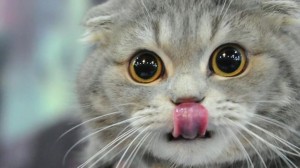Cat flu is like a human cold – it can cause a runny nose and eyes, and a sore throat. Other symptoms include aches and pains in the muscles and joints, mouth ulcers, dribbling, sneezing, loss of voice and fever. Cat flu is not usually serious in adult cats, although they can be quite ill. All cats with symptoms of cat flu should see the vet.
However it can be serious, even fatal, in kittens, and in adult cats with other serious underlying illnesses. There are occasional occurrences of a severe form, especially in the US, but thankfully this remains rare.
The usual concern is the risk of lasting damage to the eye, even in animals which otherwise seem mildly affected. Eye ulcers are often found and, particularly in kittens, can progress to cause serious damage and even lead to the loss of an eye. If your cat or kitten has a sore looking or partially closed eye seek immediate veterinary attention.
What causes cat flu?
It is usually caused by one of two types of virus, or sometimes by certain types of bacteria. Once infected, cats shed virus particles in nasal and eye discharges and in saliva. Although ill cats are the biggest source of infection, some healthy cats are carriers of the viruses. Carriers do not suffer from the disease but they too can shed virus particles and infect other cats. Particles can survive for up to a week in the environment, so a cat does not even need to meet another to catch the illness. It can easily be spread by contact with infected feed bowls or toys, or on people’s clothing after touching an infected cat.
Diagnosis of cat flu may be made by taking swabs and looking for the virus but, in most pet cats, this is not necessary as there is no specific treatment. It may be helpful in catteries or if a cat is suffering from one of the long-term complications of infection.
How is cat flu treated?
There are no effective antiviral drugs in common use. Antibiotics may help because, just as in human flu, once the virus has damaged the delicate lining of the nose and airways, bacterial infections can enter and cause complications, such as pneumonia.
Nursing care at home is important. A blocked nose and mouth ulcers may stop a cat eating and drinking, leading to dehydration, which can be particularly dangerous in kittens. Because your cat may have lost its sense of smell and have a sore throat, sloppy, strong-smelling foods should be offered. Suggestions include sardines, pilchards, roast chicken, or one of the invalid diets available from vets. Cream or ice cream may be taken if your cat has mouth ulcers – there are many points of view about the advisability of giving dairy products to cats. We don’t consider that they cause problems in cats that are used to consuming milk, cheese or yoghurt but, as with any food, we wouldn’t advise giving a large amount to a cat that has never had them before. But mixing water with any normal food is a good idea too. Cats that cannot eat may need to be hospitalised for treatment.
Encourage your cat to drink, as fluids help to loosen thick catarrhal secretions. Wipe away discharges from the nose and eyes regularly using salt water (a teaspoonful of salt to a pint of water). Steam inhalations help to loosen catarrh, so let the cat in the bathroom when you have a bath or shower.
Are there long-term consequences of cat flu?
Following infection, many cats are left as carriers, which means they do not have any symptoms but are potentially infectious to others. The existence of carriers can be the reason why a kitten develops flu when introduced to a household of apparently healthy cats.
Some carrier cats occasionally have a runny eye or nose for a few days. Recurrences of flu can follow stressful events, such as a visit to the vet or the arrival of a new cat in the house. Others are more unlucky and are left with a permanent, lifelong, thick, runny nose, or “chronic rhinitis”. This happens because the delicate nasal lining has been damaged, allowing repeated bacterial infections for which antibiotics may
provide only temporary relief.
It is thought that flu viruses, especially calicivirus, may contribute to long-term inflammation and soreness of the mouth, or gingivitis. However, this is a complicated condition, which is often difficult to cure, and calicivirus may not be the only cause. Long-term drug treatment is often needed for control, and in some cases extraction of the teeth may be needed.
Can cat flu be prevented?
There are lots of different strains of virus, and, just as with human flu, the vaccine is not effective against them all. Two doses of vaccine are needed initially, followed by regular boosters. You should consult your vet for details. It is particularly important to remember that your cat will need to be fully up to date with vaccinations if they will be going to a boarding cattery when you are on holiday.
The vaccines routinely used in the UK are only active against viruses. Vaccines are also available for the bacterial forms of cat flu. If you are breeding or showing cats, you should discuss whether these are necessary with your vet.
Even vaccinated cats can become carriers without showing any symptoms and can infect other cats. Kittens initially get some immunity from their mothers but, as they get older, this fades and they become susceptible to the infection. Infected mothers can infect their kittens without showing illness themselves. The kittens either get flu or become symptom-free carriers. It can take as long as two weeks for signs of flu to appear, so one reason for apparent vaccine “failures”, especially in kittens, may be that they are already infected at the time of vaccination. The vaccine, as with all vaccines, cannot prevent symptoms from occurring if the animal already has the infection at the time of vaccination.
Cat flu in rescue catteries
Cat flu can be a real problem in any situation where a group of cats is kept, particularly if new cats are often introduced. Preventing the entry of cat flu into a group of cats is a complex issue and full discussion with your vet is essential.
At the very least, all new cats – even if they seem healthy – should be kept separate from the rest for at least two weeks, and they should be vaccinated before they mix with the others.
Cat sneezing
Bear in mind that droplets from a cat sneezing, can transmit infection over a distance of many metres. It is best to keep mothers with litters of kittens in isolation until the kittens are ready to go to new homes. If you have a problem with cat flu within a group of cats, it is best to stop introducing further cats to the household or cattery.
Know your enemy  – further information about the bugs behind cat flu
– further information about the bugs behind cat flu
There are two main viruses. One is a type called a calicivirus, and the other is a feline herpes virus. The calicivirus exists in lots of slightly different forms, called strains. Vaccination against calicivirus is difficult, as it is with the human flu viruses, because the vaccine cannot cover all the strains, so it is not fully protective. Fortunately, the herpes virus has only one strain, so vaccination against this works better.
The actual symptoms caused by the two viruses are slightly different. Calicivirus is usually milder and characteristically causes mouth ulcers. In young kittens, it can cause lameness. Herpes virus is often more severe and is more likely to produce eye ulcers.
The situation with carriers is also different between the two. Following infection with the herpes virus, it is thought that all cats become carriers, but they produce the virus in tears, saliva and nasal secretions only intermittently. This means swabs taken from these cats will not always detect the virus. Cats that are carriers remain so for life.
With calicivirus, carrier cats shed virus particles continuously, so they are easier to identify on swabs taken by the vet. Many cats are able to completely rid their bodies of the virus after one to two years, so that they are no longer carriers.
There are also several types of bacteria that may cause flu. One of these – bordetella bronchiseptica – is the agent that causes kennel cough in dogs and it is thought that it may be possible for cats to catch “flu” from dogs. This bacterium often seems to affect the lungs as well. It can usually be successfully treated with antibiotics. A vaccine is available, but is not usually given routinely, although it is sometimes used in breeding catteries.
The other bacterium sometimes encountered is chlamydophila felis. This mainly produces sore, red, runny eyes, sometimes with a mild “cold”. Some types of antibiotics are effective and a vaccination is available, although it is not fully protective. It can be difficult to get rid of this infection completely from a group of cats.

